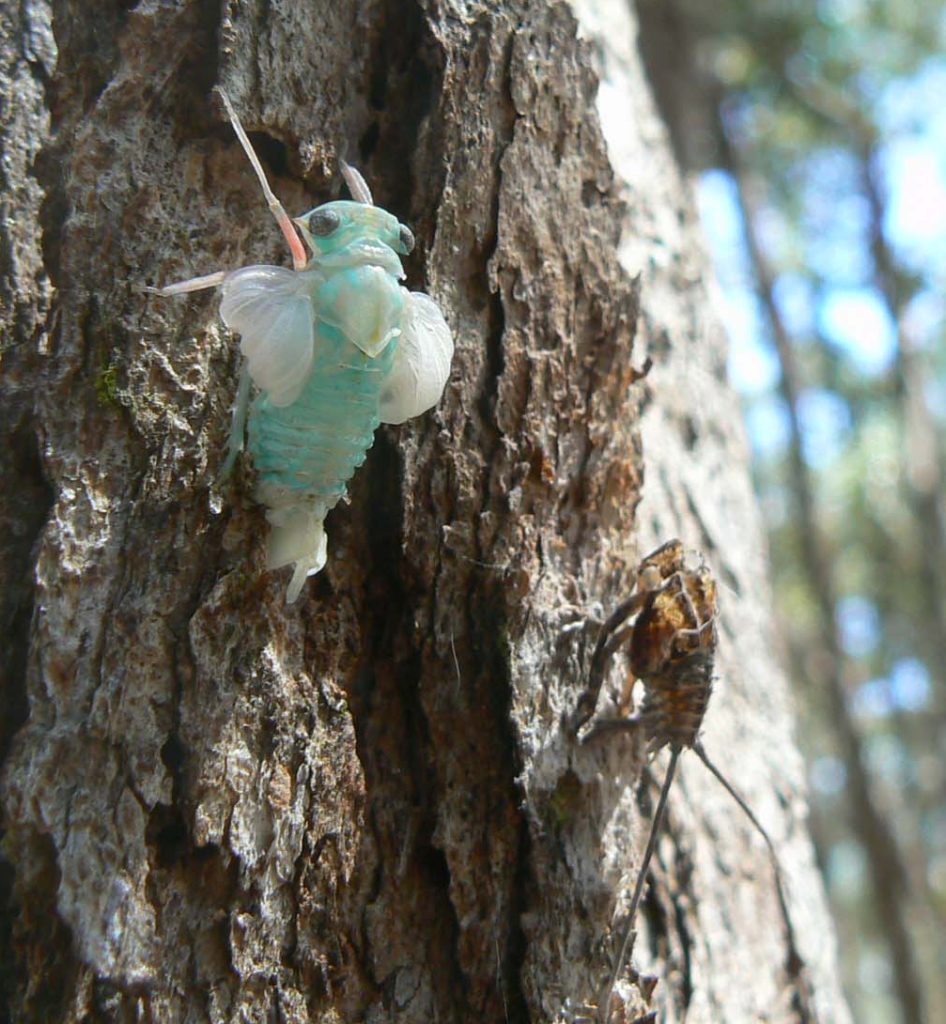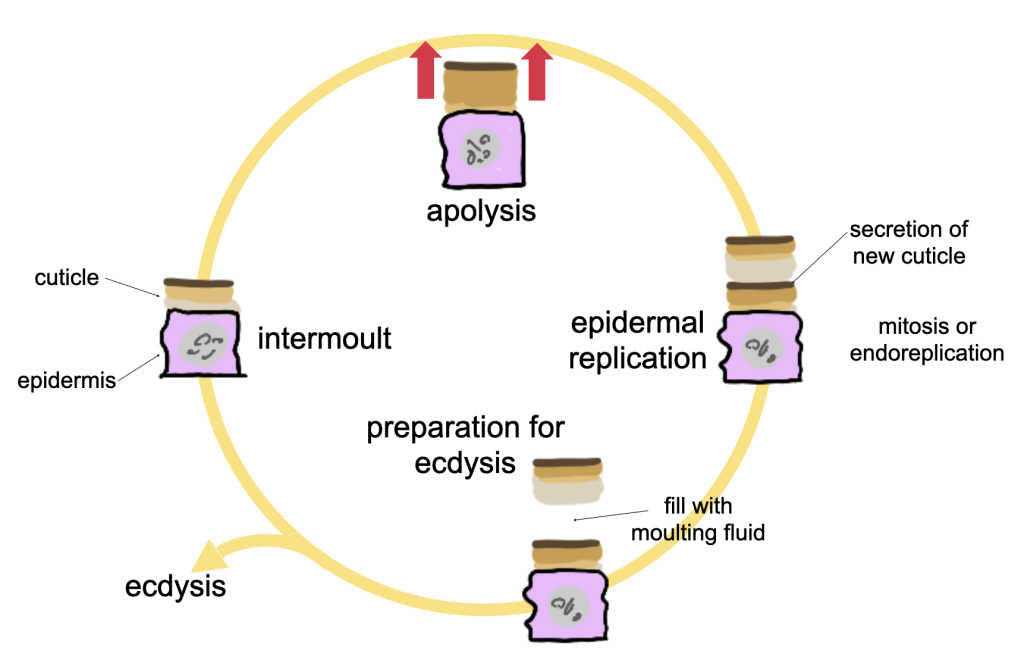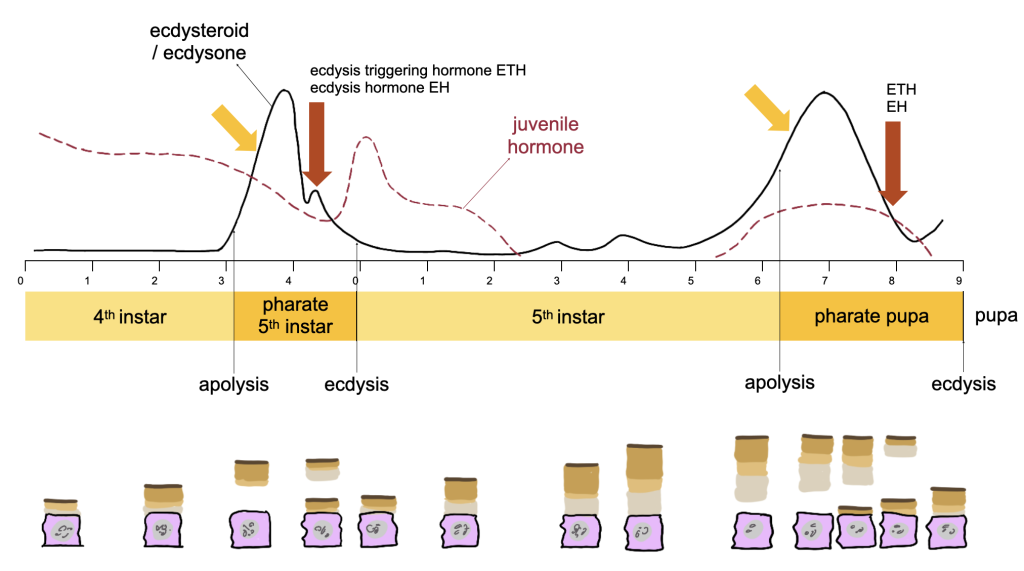6 The Challenge of Moulting

To grow, insects must moult. Moulting imposes major restrictions on insects: a new cuticle has to be formed under the old before it is cast off, and insects are immobile for a while after each moult and exposed to predation. We examine the complex hormonal processes involved in moulting and through the use of videos, we look at how insects moult.
Learning Objectives
- know the terms used to describe the moulting process
- be able to describe the basic cuticular and hormonal events associated with moulting
- understand the relevance of moulting to the success of insects
- be aware of how the developmental rate of insects varies with temperature
The Process of Moulting (Ecdysis)
The life histories of insects are many and varied, however they all reflect the need to moult to grow. Insects grow in discrete steps. In some insects the cuticle is rigid while in others—the soft-bodied insects—it can stretch.
THRD0023 019 (YouTube, 5m 05s):
The majority of insects cannot grow in between moults because the cuticle doesn’t allow for expansion, especially in the head and thorax. It is relatively easy to determine what stage a nymph is at from its overall size. On the other hand, larvae of holometabolous insects can be harder to “age” because the cuticle can be softer and the body might expand through the instar. However, the size of the head capsule is a useful indicator of instar because it is sclerotised and does not change in size through an instar.
Hormones control the timing of the moult cycle and the progression through the life-history phases.
The moult cycle is a continuous, ongoing process that terminates only after adulthood is reached. It involves the following steps, progressing clockwise in the diagram:

- Apolysis – The old cuticle separates from the new cuticle so the insect has two cuticular layers. Often we are not aware that an insect is at this stage (called the pharate stage, for example a 2nd instar larva that has undergone apolysis is called a pharate 3rd instar: think of pharate as meaning “in hiding”). Caterpillars undergo a stage called head slip that indicates they are pharate.
- Epidermis replication by mitosis. This is the stage at which the number of cells increases.
- Secretion of moulting fluid and digestion of the inner layer of cuticle. Digestion allows recycling of nutrients.
- Secretion of new cuticle
- Ecdysis is the physical removal of the old cuticle. It is the most visible part of the moult cycle. Immediately after ecdysis an insect is at a vulnerable stage as locomotion is compromised and the body is soft and flexible. On eclosion, the wing epidermal cells change shape from cuboid (rounded) to squamate (flattened). The wings appear to inflate. Stereotyped behavioural steps are needed to release old cuticle, split the old cuticle along lines of weakness (called sutures) and extract the legs and abdomen. Shivering and pulsating muscular activity is often seen. Usually, a dorsal midline split in the thorax is the main point of emergence from the old cuticle. The adult ecdysis is the most challenging because the wings have to be extracted from the wing buds and allowed to expand and harden. The cast-off cuticle is called an exuvium. The tracheal linings are extracted as well. The intermoult period is the longest duration component of the moult cycle.
Hormones Involved in Moulting
THRD0023 020 (YouTube, 5m 12s):
Hormones control the timing of the moult cycle and the progression through the life-history phases. One of the hormones involved in moulting is juvenile hormone (JH). The level of JH dictates the stage identity at the next moult. Lack of JH at the last moult results in an adult. JH is secreted by neurosecretory cells of the brain, located in a section called the corpora allata.
Eclosion hormone (EH) and ecdysis-triggering hormone (ETH) are the two main ecdysteroid hormones involved in regulation of moulting.
Prothoracicotropic hormone (PTTH) is released by the activity of neurosecretory cells in the brain. This hormone acts on the prothoracic gland, causing it to produce a pro-hormone, ecdysone, that is then changed into the active eclosion hormone, 20-hydroxyecdysone.

Rates of Development
As poikilotherms, the developmental rate of insects depends on temperature. It is important in pest monitoring to be able to predict future pest problems based on the temperatures experienced over the preceding days. It is important in forensic entomology to estimate the time at which eggs were laid on a corpse derived from the stage of the maggots collected and the temperatures experienced since oviposition. Each species has a minimum and a maximum threshold temperature below and above which development ceases.
The method used to determine developmental rates is called a day-degree method. It is based on estimating the accumulation of “heat units”. In the laboratory, the species under investigation is reared at a range of constant temperatures. The upper and lower temperature thresholds are then estimated. Temperatures recorded at the site itself are then used to estimate the accumulated heat units and relate to the expected rate of development of the insects.
Interesting Facts
- Insecticides have been developed that target the moulting hormones: they are non-toxic to vertebrates as we don’t moult! They are called insect growth regulators (IGRs). Methoprene is a common IGR used for flea control.
- What instar caterpillar? Measurement of head width is generally used as a reliable indicator because the head capsule cuticle is hardened whereas the body is relatively flexible. Read more in Morphology and Morphometry of Aedes aegypti Adult Mosquito.
- To maintain sensitivity of the sensory system between apolysis and ecdysis, the neurons of the sense organs run through the moulting fluid space.
Activities
Activity 6.1
Watch this time-lapse video of mantispid lacewing (YouTube, 1m) (Neuroptera) eclosion. The video was taken by Dr James Dorey, a former BIOL2205 student! Note the position of the wings once they have become fully expanded.
Activity 6.2
Look up the meaning of the cuticular structures called “acarinarium” and “mycangium”. What are their functions?
Activity 6.3
Here are more videos that illustrate and further explain the moulting process:
- Watch these moulting videos from Texas A&M university:
- Watch a stick insect moult: (Questacon video, 55s)
Topic Review
Do you know…?
- The names of the main hormones that regulate moulting
- The stages of the moult cycle?
- The difference between apolysis and ecdysis?
- Why insects are vulnerable around the time of moulting?
- The locations of the glands that release juvenile hormone and prothoracicotropic hormone?

